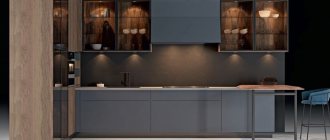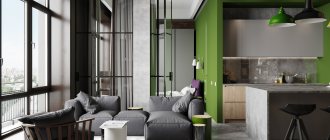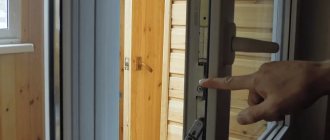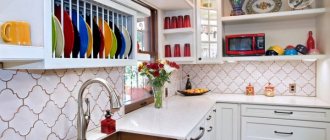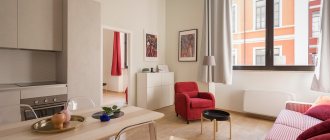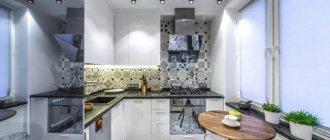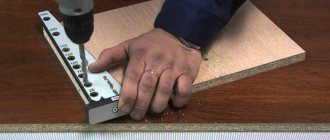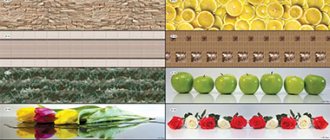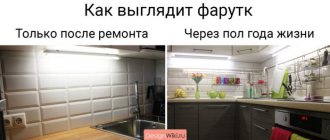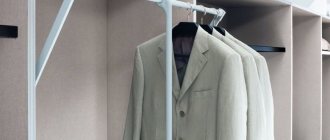Glass is an excellent alternative to classic tiles, which were used to decorate the kitchen backsplash by our grandmothers, and continue to be used by us. Tempered glass is an excellent material for kitchen surfaces, which withstands moisture and steam and is easily cleaned from any dirt. And given the fact that it has the widest possibilities for decoration, for example, photo printing, glass aprons have become a real trend among interior designers. Skinali is another name for tempered glass with an image. Let's figure out what it is?
Article navigation:
|
You can often hear the following opinion of skeptics: “On shiny glass, small drops of water, grease, handprints, and the slightest particles of dust will always be visible.” All these objections are dispelled by those who have already installed glass surfaces: no more dust and marks remain on the glass than on ceramics, and the absence of seams, like between ceramic tiles, makes cleaning the apron as convenient and simple as possible.
What is skinali?
Skinali is a trendy element of kitchen decoration, most often made of tempered glass. In another way it is called a kitchen apron. In addition to their decorative function, skinali is an excellent option for functional protection. Tempered glass is seven times stronger than regular glass, so it can easily withstand the high temperatures it can be exposed to in the kitchen, and is also easy to clean.
Depending on the style of the kitchen interior, you can choose a suitable pattern of any complexity, which will be applied to the skins using ultraviolet printing. Temperature will not affect the quality of the drawing in any way. If all technologies are followed, it will remain in its original form.
An increasing number of people are installing tempered glass skins in their kitchens. The popularity is due to a number of reasons:
- Practicality. Durable material eliminates damage from mechanical damage, is resistant to high humidity, is easy to clean and is not afraid of temperature fluctuations;
- Easy installation. The work takes on average 1.5-2 hours, but the area of the kitchen should be taken into account;
- Non-toxic. Skinali is the latest development, made of environmentally friendly material, absolutely safe for humans;
- Functionality. Installing a skinal prevents the formation of mold, damage to walls and fading;
- Easy care. To maintain cleanliness, when dirty, you need to wipe the skins with a sponge moistened with soap or plain water.
The use of a skinali in a kitchen interior is an interesting design solution that will highlight the style of the interior thanks to the variety of shapes and patterns. They can be transferred to tempered glass from an existing photograph. The price range varies, so this finish is available to people with different budgets. The cost depends on the manufacturer and material.
Due to the fact that skins came to the Russian market not so long ago, some potential buyers still do not know about them, and many people may have doubts about their installation due to the fact that the technology is new for our market.
What advantages do skinals give us?
- An endless number of design variations. Regardless of what style the kitchen is decorated in, skinals can become a bright accent or addition.
- Easy production and installation.
- Possibility to withdraw skins at any time.
- Many varieties.
In conclusion
Glass skins are a suitable material for the kitchen in terms of appearance and performance, and the high price is more than offset by durability and strength. Such a finishing element will make the kitchen original, add zest and the illusion of additional space. The main thing is to choose the right pattern and think in advance about the location of all possible holes in the work area.
The article was written for the site.
Tags:Kitchen
Varieties
Modern design solutions require a large selection of kitchen interior options, so from a large number of variations of skinali, you can choose canvases with a unique design that will look harmonious in the kitchen. The apron can be made from various types of glass, but tempered glass is preferable.
Glass splashbacks have many advantages, so it’s worth highlighting them:
- practicality;
- reliable protection from dust and grease;
- no need to frequently wash the surface;
- fire safety;
- increased strength (for some materials);
- long service life (for some materials);
- many design solutions;
- attractive price category.
Let's analyze each material in detail.
Glass
Decorative panels perform a protective function for the area around the stove and do not require complex maintenance. Not the most durable material, since damage can occur as a result of temperature changes, careless handling, and even during installation work.
Strained glass
An absolute bestseller, seven times stronger than ordinary glass. By choosing tempered glass skins, you will receive a product that is resistant to temperature changes, dampness, and mechanical damage. The most commonly chosen thickness is 4-7mm. As with regular glass skins, the print is applied using UV printing. The average service life is 10 years, but much depends on the manufacturer and the operating conditions themselves. The presence of holes for sockets and their size are discussed in advance, since once the material has been hardened, changes are no longer possible.
Plexiglas
Plexiglas is a light and fragile material, so cracks and scratches will occur in any case. The service life of the apron can only be extended with very careful handling. The design is applied to a film, which is glued to the front part of the skin, after which lamination occurs. To create a durable apron that will last for many years, it is not recommended to use plexiglass.
Triplex
Quite a rare choice of material for an apron. Cracks most often appear in the area where the slab is located as a result of temperature changes. The pattern is applied to the film, which is located between two layers of material. The print may lose saturation due to exposure to sunlight.
Polycarbonate
Choosing polycarbonate as a material for skinals greatly simplifies their installation, as it is durable and unbreakable. The material has the lowest flammability class, so its installation in the stove area is safe. During installation, you can make holes for sockets and other needs. It is impossible to break a kitchen apron made of polycarbonate; it is resistant to temperature changes and involves applying a design using photo printing. This material can be recommended as reliable and durable.
The most durable materials are tempered glass and polycarbonate.
Glass splashback dimensions
Let's look at the vertical size. The classic height of the apron is 60 cm. The design of a modern kitchen makes its contribution, and the distance from the countertop to the upper cabinets can be from 40 to 90 cm. The height of the apron is determined by the convenience of the kitchen user. If the housewife is short, then the countertop and upper cabinets are installed lower than the standard. If, on the contrary, the height is above average, then the cabinets are mounted at a greater distance from the working surface. In any case, you need to consider the ease of use of the kitchen, so the size of the glass apron will be determined by the distance between the countertop and the upper cabinets.
Horizontal size. Everything is simple here: how long is the kitchen - so long is the apron. For small rooms, one wall panel is enough. If you are the happy owner of a large kitchen, you will need to make an apron from several parts. If the work is done efficiently, the joints will be invisible even to a person with 100% vision.
Experts recommend:
Apron made of 5mm glass - the length of one wall panel should not exceed 2.5 meters.
An apron made of 6mm glass is suitable for a length of more than 2.5 meters and very uneven walls
An 8mm glass apron is an uncompromising solution with a fair margin of safety; in some cases it can act as a self-supporting structure.
Tips for choosing
Elements in apartments or private houses with a thoughtful design always harmonize with each other. This should also apply to the kitchen. Having decided in what style it will be finished, you can think about what the skins should be like.
The simplest solution is that the skins should be made in the same shades as the kitchen furniture.
There is also an option for those who like non-standard solutions. In the kitchen, skinals can be a bright accent, made in a contrasting shade. If you are interested in the latter option, we recommend consulting with a designer so as not to end up with a tasteless kitchen.
It is a well-known fact that light shades visually increase the space of a room, so choose light shades if you have a small kitchen and want it to seem more spacious.
Important! Skinali are made from frosted and glossy glass. Keep in mind that while frosted glass may look more stylish, it is more difficult to clean.
If you always want to impress your guests and love unusual design solutions, take a closer look at backlit glass skins. Photo printing of an image of an evening view of one of the megacities will help add originality to the interior. In the evening you can enjoy the view of Paris or New York while drinking tea or coffee.
Skins that match the color of the walls are suitable for kitchens where the design is already overloaded with a variety of colors. This way it will become more restrained and add style to the interior.
Playing with contrasts may not always be appropriate in the interior, but for kitchens with dark furniture, light skinnels will look stylish.
When choosing a material, weigh the pros and cons, as each has its own pros and cons.
Leveling walls before installation
If the curvature is obvious, alignment is indispensable. If it barely shows up, just apply a layer of plaster and start installation. The installation of the skin must be done exclusively at the final stage of repair, and after the set is assembled.
The dimensions of the glass panel cannot be “adjusted” or slots for fasteners can be made in it. Therefore, it is better to measure everything to the nearest millimeter. Any kitchen will look impressive with a natural landscape or a photograph of a night metropolis: the most modest space expands its boundaries.
Which pattern and color should I choose?
The main advantage of skinals is the possibility of using them in kitchens, the interior of which is made in different styles. It depends on the style whether the option will be plain or with a pattern.
Styles where plain skins fit perfectly
Minimalism implies the absence of unnecessary decor or a minimal amount of it. A matte or glossy glass surface will highlight the minimalist design of the kitchen.
Japanese style requires a large amount of free space, the absence of bright accents and a minimal number of decorative elements. An apron in pastel colors can easily play up the main principles of this trend.
High-tech kitchens are distinguished by the presence of stylish household appliances and restraint. The color of the apron can be anything from white to neon pink.
Applying images
There are several ways to apply images to a surface. The most popular are photo printing using special ultraviolet ink and the application of polymer film. The main advantages of UV printing are high clarity of printed images, high-quality color rendering, environmental friendliness and durability of products.
When using polymer film, obtaining high quality is only possible using expensive technological equipment. Sometimes installing transparent panels over existing finishing material is used. In this case, the apron performs a purely protective function. Glass can be tinted or painted. The use of bright and beautiful images allows you to complement the existing kitchen interior or create the right atmosphere for cooking and eating. Glass protective panels are most harmoniously combined with modern interior styles: high-tech, modern and minimalism.
Also, when decorating, a mirror surface can be used, which helps to visually expand the space of the room. Particularly high-quality varieties are panels consisting of two layers of tempered glass with an image located between them.
Skinali with a pattern: a flight of design ideas
Ethno style, national motifs of Morocco, India or any other country you choose will be complemented by an apron with a landscape or ornament.
Country style, for kitchens in a “rustic” style, skins depicting national dishes or natural products will be an interesting solution.
The increasingly popular loft style with imitation of bare walls will be complemented by a panel depicting brickwork.
Modern. If you didn’t opt for a city panorama, then choose laconic images, for example, a floral print.
Classic. A large selection of panels for prints makes it possible to practically not limit ourselves to the framework into which any style forces us one way or another. Classic gives us much more space for flight of fancy. Nature, geometry, abstraction or something else - everything is in your hands.
Provence - delicate French style will be complemented by flower buds in pastel shades.
Tastes could not be discussed. And about the design of kitchen aprons too
Some feel comfortable in crowded rooms with an abundance of carpets, crystal and some kind of memorabilia. Some people don’t want to see “all this junk” in their living space and find their comfort in minimalism. Loft and artsy baroque classics also have their place.
Just like the bright glass apron we threw off for the kitchen.
If the housewife likes to look at the panorama of the city while cooking or admire flowers and juicy berries - so be it. This is her personal matter.
How to decide on a color?
- Matching the color of the furniture creates a feeling of unity and is suitable for kitchens in light shades.
- They threw it in the color of the walls. If there is too much color in the kitchen details and furniture, you can not focus on the skinal and decorate it in the color of the walls.
- A contrasting apron always looks impressive: for bright furniture you should choose a contrasting apron in calm shades, for light furniture - brighter options.
Skinals are increasingly found in design projects due to not only their stylish visual component, but also their functionality. By successfully choosing an apron, you will become the owner of a truly stylish kitchen.
Manufacturing technology
Kitchen skinals are made from various materials and with different techniques for applying pictures.
More: Criminology, victimology, criminology - criminal sciences
Operating procedure:
1). The material for the base is selected.
2). Preparing the slab: cutting to size, finishing the edges, sawing or drilling for sockets, switches, hooks.
3). The image is drawn.
Real examples of skins for the kitchen
What are we talking about?
Designers called skins glass panels on which some image is applied from the inside. Initially, such elements were only the prerogative of an apron, but over time, kitchen skins began to be used in wall decor, as well as in the decoration of ceilings and in the form of facade inserts in sets.
Bright glass kitchen skins
The new product attracts consumers with its colorfulness and variety of picture subjects offered. With their appearance, a kitchen apron can take on the appearance of a real work of art. Photo printing of images on glass is carried out in such amazing quality that the paintings literally come to life, and the shine of the glass gives them a special cheerfulness. Even the most standard kitchen in a boring, primitive design, with the advent of the skinali, acquires individuality and looks like an original work.
Skinali will make your kitchen bright and original
The best
Triplex (laminated glass) is considered one of the highest quality materials for making skinali. These are practically eternal panels, not subject to abrasion or mechanical stress, and can withstand impacts of enormous force. The image can be applied either from the back side or “mounted” during production.
At one of the gluing stages, the film with the image is inserted inside and the pattern is sealed. Such technologies provide strength and abrasion resistance. The flat, smooth surface of the glass lends itself to wet cleaning.
